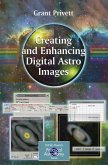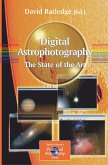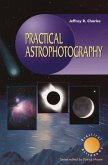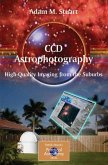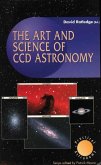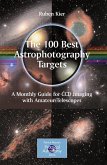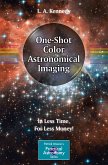In the last few years, cheap webcams have revolutionized amateur astronomy by providing a very inexpensive alternative to purpose-made astronomical CCD cameras, which use refrigerated imaging chips and are thus extremely expensive. Webcams are capable of more advanced work than 'normal' digital cameras because their simple construction makes it easy to remove the webcam's lens, allowing it to be interfaced directly to a telescope. Using a webcam is not difficult but most amateur astronomers who have tried to do this do not achieve the finest results, despite the webcam's potential. There are numerous imaging and image processing tricks and techniques, and all of them are needed to get the best results.
Along with webcam technology has come simple-to-use image processing and enhancement using a PC: the most powerful technique is, 'stacking' in which the best images (out of hundreds) are selected and summed automatically to provide startlingly good results.
"Lunarand Planetary Webcam User's Guide" de-mystifies the jargon of webcams and computer processing, and provides detailed hints and tips for imaging the Sun, Moon and planets with a webcam. He looks at each observing target separately, describing and explaining all specialised techniques in context.
Glance through the images in this book to see just how much you can - easily - achieve by using a webcam with your telescope!
Along with webcam technology has come simple-to-use image processing and enhancement using a PC: the most powerful technique is, 'stacking' in which the best images (out of hundreds) are selected and summed automatically to provide startlingly good results.
"Lunarand Planetary Webcam User's Guide" de-mystifies the jargon of webcams and computer processing, and provides detailed hints and tips for imaging the Sun, Moon and planets with a webcam. He looks at each observing target separately, describing and explaining all specialised techniques in context.
Glance through the images in this book to see just how much you can - easily - achieve by using a webcam with your telescope!
From the reviews:
[This book] is superb! I am still falling off webcam learning curves, so I found many good nuggets of information in the book. I especially liked the in-depth analyses of the Moon and planets--it provides good direction on what to image. --Don Parker
"Astronomers now recognize that webcams are the best thing to happen to planetary observing since Galileo first pointed a telescope at Jupiter nearly 400 years ago. ... So it is timely that Martin Mobberley has added to Springer's burgeoning Practical Astronomy Series with a comprehensive guide to exploit this exciting technology ... . this is a good book that contains information and hints that will benefit both the beginner and the more experienced imager. It's written in a style that is clear ... . Recommended." (Grant Privett, Astronomy Now, December, 2006)
"In the last few years ... webcams have revolutionized amateur astronomy ... . This book demystifies the jargon of webcams and computer processing, and provides detailed hints and tips for imaging the Sun, Moon, and planets with a webcam. The author looks at each observing target separately, describing and explaining all specialized techniques in context. Glance through the images in this book to see just how much you can easily achieve by using a webcam with your telescope." (Lunar and Planetary Information Bulletin, 2007)
"Martin Mobberley is a well known observer and imager. In this book he takes a hands on look at webcamming the Solar System. ... is very well written and easy to understand. The step guides are clear and I would recommend this book to both experienced and novice imagers alike. In fact even if you're not interested in hi resolution imaging the story of the rectal bung makes this a great read....Youl'll have to buy the book though to find out more ... ." (Dave Gradwell, Astronomy and Space, February, 2007)
[This book] is superb! I am still falling off webcam learning curves, so I found many good nuggets of information in the book. I especially liked the in-depth analyses of the Moon and planets--it provides good direction on what to image. --Don Parker
"Astronomers now recognize that webcams are the best thing to happen to planetary observing since Galileo first pointed a telescope at Jupiter nearly 400 years ago. ... So it is timely that Martin Mobberley has added to Springer's burgeoning Practical Astronomy Series with a comprehensive guide to exploit this exciting technology ... . this is a good book that contains information and hints that will benefit both the beginner and the more experienced imager. It's written in a style that is clear ... . Recommended." (Grant Privett, Astronomy Now, December, 2006)
"In the last few years ... webcams have revolutionized amateur astronomy ... . This book demystifies the jargon of webcams and computer processing, and provides detailed hints and tips for imaging the Sun, Moon, and planets with a webcam. The author looks at each observing target separately, describing and explaining all specialized techniques in context. Glance through the images in this book to see just how much you can easily achieve by using a webcam with your telescope." (Lunar and Planetary Information Bulletin, 2007)
"Martin Mobberley is a well known observer and imager. In this book he takes a hands on look at webcamming the Solar System. ... is very well written and easy to understand. The step guides are clear and I would recommend this book to both experienced and novice imagers alike. In fact even if you're not interested in hi resolution imaging the story of the rectal bung makes this a great read....Youl'll have to buy the book though to find out more ... ." (Dave Gradwell, Astronomy and Space, February, 2007)


